我们先回想一下Kafka的日志结构是怎样的?
Kafka 日志对象由多个日志段对象组成,而每个日志段对象会在磁盘上创建一组文件,包括消息日志文件(.log)、位移索引文件(.index)、时间戳索引文件(.timeindex)以及已中止(Aborted)事务的索引文件(.txnindex)。当然,如果你没有使用 Kafka 事务,已中止事务的索引文件是不会被创建出来的。
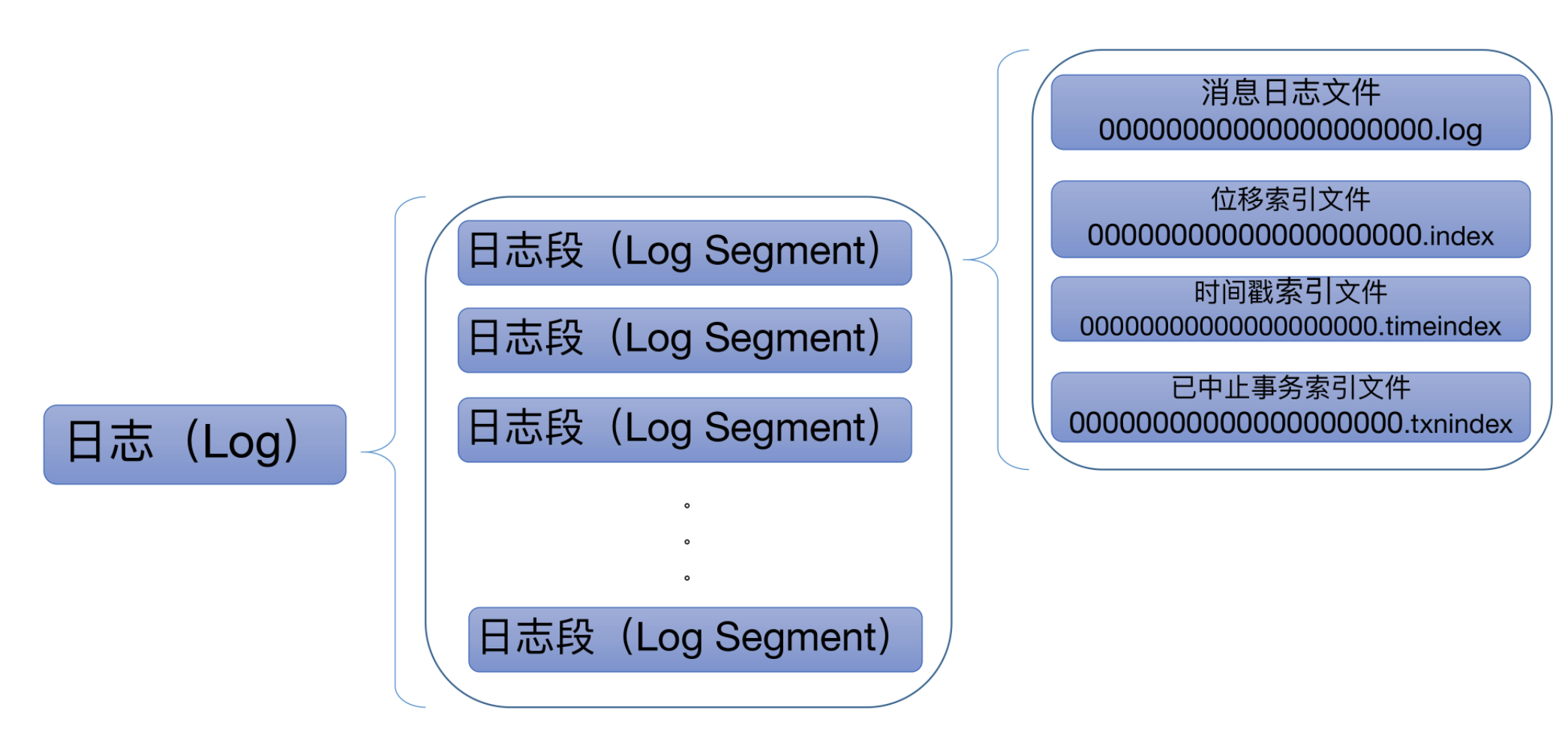
下面我们看一下LogSegment的实现情况,具体文件位置是 core/src/main/scala/kafka/log/LogSegment.scala。
LogSegment.scala这个文件里面定义了三个对象:
我这里贴一下LogSegment.scala这个文件上面的注释,介绍了LogSegment的构成:
A segment of the log. Each segment has two components: a log and an index. The log is a FileRecords containing the actual messages. The index is an OffsetIndex that maps from logical offsets to physical file positions. Each segment has a base offset which is an offset <= the least offset of any message in this segment and > any offset in any previous segment
这段注释清楚的写了每个日志段由两个核心组件构成:日志和索引。每个日志段都有一个起始位置:base offset,而该位移值是此日志段所有消息中最小的位移值,同时,该值却又比前面任何日志段中消息的位移值都大。
class LogSegment private[log] (val log: FileRecords,
val lazyOffsetIndex: LazyIndex[OffsetIndex],
val lazyTimeIndex: LazyIndex[TimeIndex],
val txnIndex: TransactionIndex,
val baseOffset: Long,
val indexIntervalBytes: Int,
val rollJitterMs: Long,
val time: Time) extends Logging { … }
FileRecords是实际保存 Kafka 消息的对象。
lazyOffsetIndex、lazyTimeIndex 和 txnIndex 分别对应位移索引文件、时间戳索引文件、已中止事务索引文件。
baseOffset是每个日志段对象的起始位移,每个 LogSegment 对象实例一旦被创建,它的起始位移就是固定的了,不能再被更改。
indexIntervalBytes 值其实就是 Broker 端参数 log.index.interval.bytes 值,它控制了日志段对象新增索引项的频率。默认情况下,日志段至少新写入 4KB 的消息数据才会新增一条索引项。
time 是用于统计计时的一个实现类。
@nonthreadsafe
def append(largestOffset: Long,
largestTimestamp: Long,
shallowOffsetOfMaxTimestamp: Long,
records: MemoryRecords): Unit = {
// 判断是否日志段是否为空
if (records.sizeInBytes > 0) {
trace(s"Inserting ${records.sizeInBytes} bytes at end offset $largestOffset at position ${log.sizeInBytes} " +
s"with largest timestamp $largestTimestamp at shallow offset $shallowOffsetOfMaxTimestamp")
val physicalPosition = log.sizeInBytes()
if (physicalPosition == 0)
rollingBasedTimestamp = Some(largestTimestamp)
// 确保输入参数最大位移值是合法的
ensureOffsetInRange(largestOffset)
// append the messages
// 执行真正的写入
val appendedBytes = log.append(records)
trace(s"Appended $appendedBytes to ${log.file} at end offset $largestOffset")
// Update the in memory max timestamp and corresponding offset.
// 更新日志段的最大时间戳以及最大时间戳所属消息的位移值属性
if (largestTimestamp > maxTimestampSoFar) {
maxTimestampSoFar = largestTimestamp
offsetOfMaxTimestampSoFar = shallowOffsetOfMaxTimestamp
}
// append an entry to the index (if needed)
// 当已写入字节数超过了 4KB 之后,append 方法会调用索引对象的 append 方法新增索引项,同时清空已写入字节数
if (bytesSinceLastIndexEntry > indexIntervalBytes) {
offsetIndex.append(largestOffset, physicalPosition)
timeIndex.maybeAppend(maxTimestampSoFar, offsetOfMaxTimestampSoFar)
bytesSinceLastIndexEntry = 0
}
bytesSinceLastIndexEntry += records.sizeInBytes
}
}
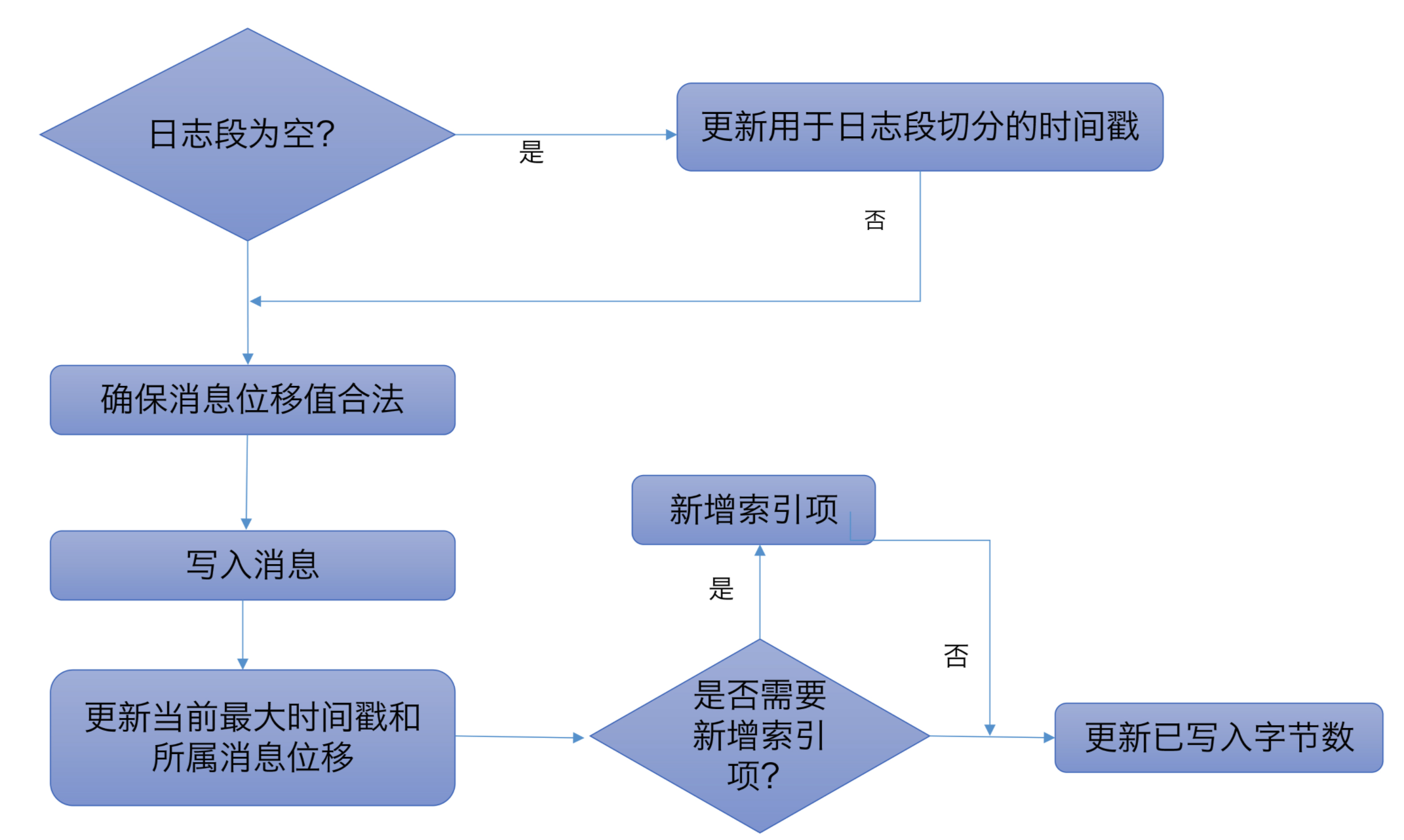
这个方法主要做了那么几件事:
我们下面再看看ensureOffsetInRange方法是怎么校验最大位移的:
private def ensureOffsetInRange(offset: Long): Unit = {
if (!canConvertToRelativeOffset(offset))
throw new LogSegmentOffsetOverflowException(this, offset)
}
这个方法最终会调用到AbstractIndex的toRelative方法中:
private def toRelative(offset: Long): Option[Int] = {
val relativeOffset = offset - baseOffset
if (relativeOffset < 0 || relativeOffset > Int.MaxValue)
None
else
Some(relativeOffset.toInt)
}
可见这个方法会将offset和baseOffset做对比,当offset小于baseOffset或者当offset和baseOffset相减后大于Int的最大值,那么都是异常的情况,那么这时就会抛出LogSegmentOffsetOverflowException异常。
def read(startOffset: Long,
maxSize: Int,
maxPosition: Long = size,
minOneMessage: Boolean = false): FetchDataInfo = {
if (maxSize < 0)
throw new IllegalArgumentException(s"Invalid max size $maxSize for log read from segment $log")
// 将位移索引转换成物理文件位置索引
val startOffsetAndSize = translateOffset(startOffset)
// if the start position is already off the end of the log, return null
if (startOffsetAndSize == null)
return null
val startPosition = startOffsetAndSize.position
val offsetMetadata = LogOffsetMetadata(startOffset, this.baseOffset, startPosition)
val adjustedMaxSize =
if (minOneMessage) math.max(maxSize, startOffsetAndSize.size)
else maxSize
// return a log segment but with zero size in the case below
if (adjustedMaxSize == 0)
return FetchDataInfo(offsetMetadata, MemoryRecords.EMPTY)
// calculate the length of the message set to read based on whether or not they gave us a maxOffset
// 计算要读取的总字节数
val fetchSize: Int = min((maxPosition - startPosition).toInt, adjustedMaxSize)
// log.slice读取消息后封装成FetchDataInfo返回
FetchDataInfo(offsetMetadata, log.slice(startPosition, fetchSize),
firstEntryIncomplete = adjustedMaxSize < startOffsetAndSize.size)
}
这段代码中,主要做了这几件事:
调用 translateOffset 方法定位要读取的起始文件位置 (startPosition)。
举个例子,假设 maxSize=100,maxPosition=300,startPosition=250,那么 read 方法只能读取 50 字节,因为 maxPosition - startPosition = 50。我们把它和 maxSize 参数相比较,其中的最小值就是最终能够读取的总字节数。
调用 FileRecords 的 slice 方法,从指定位置读取指定大小的消息集合。
这个方法是恢复日志段,Broker 在启动时会从磁盘上加载所有日志段信息到内存中,并创建相应的 LogSegment 对象实例。在这个过程中,它需要执行一系列的操作。
def recover(producerStateManager: ProducerStateManager, leaderEpochCache: Option[LeaderEpochFileCache] = None): Int = {
//情况索引文件
offsetIndex.reset()
timeIndex.reset()
txnIndex.reset()
var validBytes = 0
var lastIndexEntry = 0
maxTimestampSoFar = RecordBatch.NO_TIMESTAMP
try {
//遍历日志段中所有消息集合
for (batch <- log.batches.asScala) {
// 校验
batch.ensureValid()
// 校验消息中最后一条消息的位移不能越界
ensureOffsetInRange(batch.lastOffset)
// The max timestamp is exposed at the batch level, so no need to iterate the records
// 获取最大时间戳及所属消息位移
if (batch.maxTimestamp > maxTimestampSoFar) {
maxTimestampSoFar = batch.maxTimestamp
offsetOfMaxTimestampSoFar = batch.lastOffset
}
// Build offset index
// 当已写入字节数超过了 4KB 之后,调用索引对象的 append 方法新增索引项,同时清空已写入字节数
if (validBytes - lastIndexEntry > indexIntervalBytes) {
offsetIndex.append(batch.lastOffset, validBytes)
timeIndex.maybeAppend(maxTimestampSoFar, offsetOfMaxTimestampSoFar)
lastIndexEntry = validBytes
}
// 更新总消息字节数
validBytes += batch.sizeInBytes()
// 更新Porducer状态和Leader Epoch缓存
if (batch.magic >= RecordBatch.MAGIC_VALUE_V2) {
leaderEpochCache.foreach { cache =>
if (batch.partitionLeaderEpoch > 0 && cache.latestEpoch.forall(batch.partitionLeaderEpoch > _))
cache.assign(batch.partitionLeaderEpoch, batch.baseOffset)
}
updateProducerState(producerStateManager, batch)
}
}
} catch {
case e@ (_: CorruptRecordException | _: InvalidRecordException) =>
warn("Found invalid messages in log segment %s at byte offset %d: %s. %s"
.format(log.file.getAbsolutePath, validBytes, e.getMessage, e.getCause))
}
// 遍历完后将 遍历累加的值和日志总字节数比较,
val truncated = log.sizeInBytes - validBytes
if (truncated > 0)
debug(s"Truncated $truncated invalid bytes at the end of segment ${log.file.getAbsoluteFile} during recovery")
//执行日志截断操作
log.truncateTo(validBytes)
// 调整索引文件大小
offsetIndex.trimToValidSize()
// A normally closed segment always appends the biggest timestamp ever seen into log segment, we do this as well.
timeIndex.maybeAppend(maxTimestampSoFar, offsetOfMaxTimestampSoFar, skipFullCheck = true)
timeIndex.trimToValidSize()
truncated
}
这个方法主要做了以下几件事:
下面我们进入到truncateTo方法中,看一下截断操作是怎么做的:
public int truncateTo(int targetSize) throws IOException {
int originalSize = sizeInBytes();
// 要截断的目标大小不能超过当前文件的大小
if (targetSize > originalSize || targetSize < 0)
throw new KafkaException("Attempt to truncate log segment " + file + " to " + targetSize + " bytes failed, " +
" size of this log segment is " + originalSize + " bytes.");
//如果目标大小小于当前文件大小,那么执行截断
if (targetSize < (int) channel.size()) {
channel.truncate(targetSize);
size.set(targetSize);
}
return originalSize - targetSize;
}
Kafka 会将日志段当前总字节数和刚刚累加的已读取字节数进行比较,如果发现前者比后者大,说明日志段写入了一些非法消息,需要执行截断操作,将日志段大小调整回合法的数值。
这个方法会将日志段中的数据强制截断到指定的位移处。
def truncateTo(offset: Long): Int = {
// Do offset translation before truncating the index to avoid needless scanning
// in case we truncate the full index
// 将位置值转换成物理文件位置
val mapping = translateOffset(offset)
// 移动索引到指定位置
offsetIndex.truncateTo(offset)
timeIndex.truncateTo(offset)
txnIndex.truncateTo(offset)
// After truncation, reset and allocate more space for the (new currently active) index
// 因为位置变了,为了节省内存,做一次resize操作
offsetIndex.resize(offsetIndex.maxIndexSize)
timeIndex.resize(timeIndex.maxIndexSize)
val bytesTruncated = if (mapping == null) 0 else log.truncateTo(mapping.position)
// 如果调整到初始位置,那么重新记录一下创建时间
if (log.sizeInBytes == 0) {
created = time.milliseconds
rollingBasedTimestamp = None
}
//调整索引项
bytesSinceLastIndexEntry = 0
//调整最大的索引位置
if (maxTimestampSoFar >= 0)
loadLargestTimestamp()
bytesTruncated
}
我们到OffsetIndex的truncateTo方法中看一下:
override def truncateTo(offset: Long): Unit = {
inLock(lock) {
val idx = mmap.duplicate
//根据指定位移返回消息中位移
val slot = largestLowerBoundSlotFor(idx, offset, IndexSearchType.KEY)
/* There are 3 cases for choosing the new size
* 1) if there is no entry in the index <= the offset, delete everything
* 2) if there is an entry for this exact offset, delete it and everything larger than it
* 3) if there is no entry for this offset, delete everything larger than the next smallest
*/
val newEntries =
//如果没有消息的位移值小于指定位移值,那么就直接从头开始
if(slot < 0)
0
// 跳到执行的位移位置
else if(relativeOffset(idx, slot) == offset - baseOffset)
slot
// 指定位移位置大于消息中所有位移,那么跳到消息位置中最大的一个的下一个位置
else
slot + 1
// 执行位置跳转
truncateToEntries(newEntries)
}
}
讲完了LogSegment之后,我们在来看看Log。
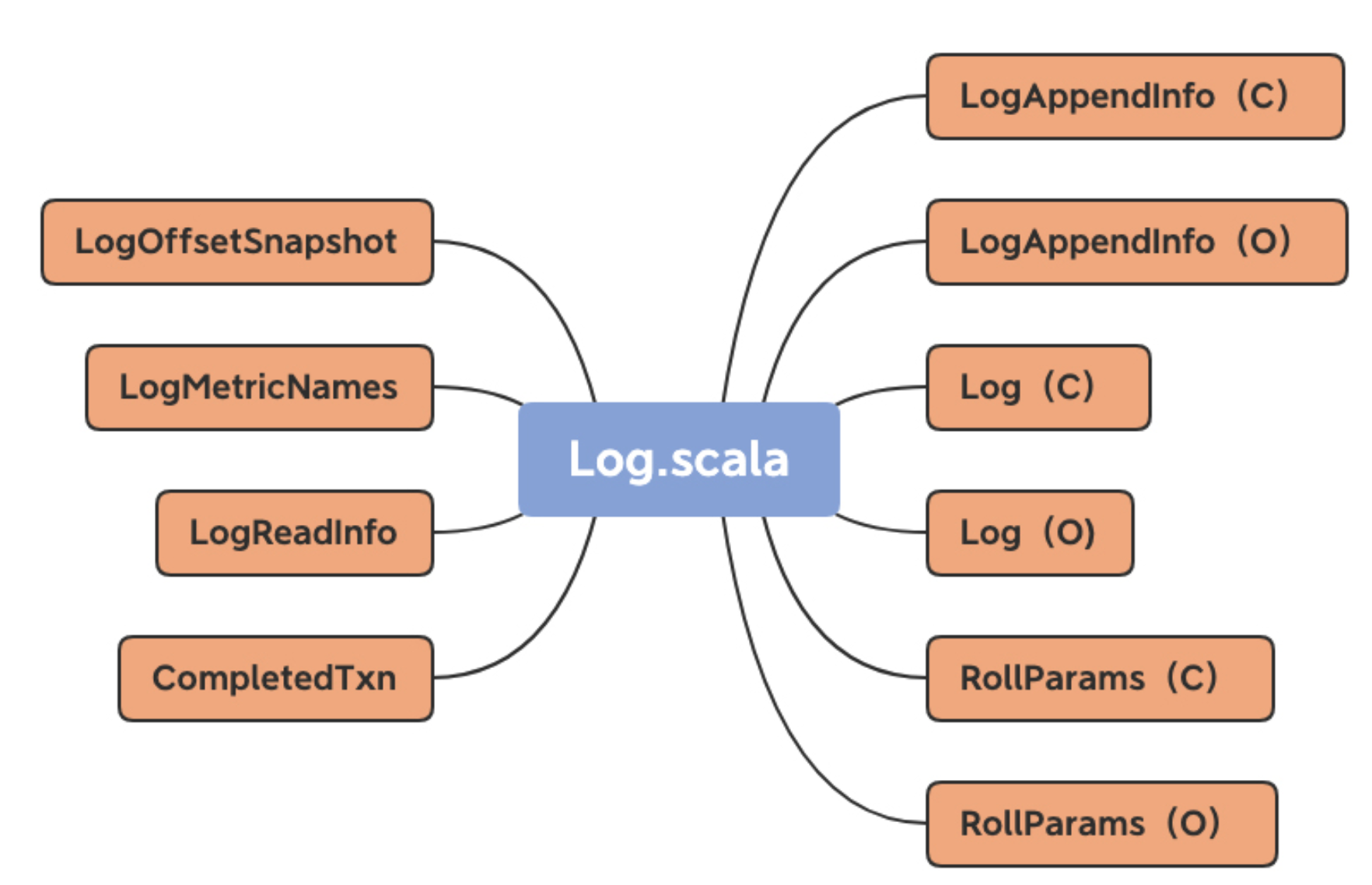
Log.scala定义了 10 个类和对象,图中括号里的 C 表示 Class,O 表示 Object。
我们主要看的是Log类:
class Log(@volatile var dir: File,
@volatile var config: LogConfig,
@volatile var logStartOffset: Long,
@volatile var recoveryPoint: Long,
scheduler: Scheduler,
brokerTopicStats: BrokerTopicStats,
val time: Time,
val maxProducerIdExpirationMs: Int,
val producerIdExpirationCheckIntervalMs: Int,
val topicPartition: TopicPartition,
val producerStateManager: ProducerStateManager,
logDirFailureChannel: LogDirFailureChannel) extends Logging with KafkaMetricsGroup {
……
}
主要的属性有两个dir和logStartOffset,分别表示个日志所在的文件夹路径,也就是主题分区的路径以及日志的当前最早位移。
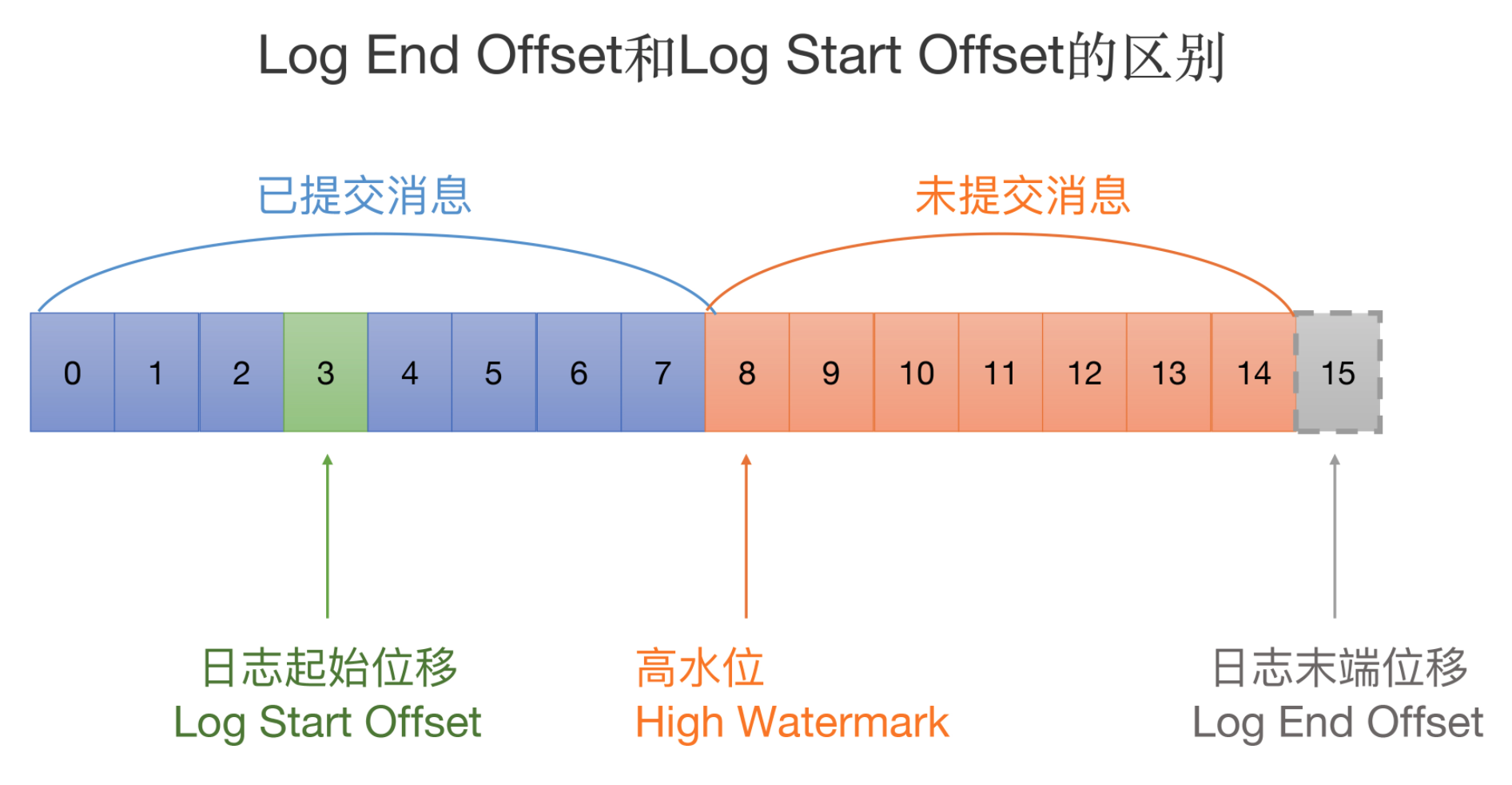
在kafka中,我们用Log End Offset(LEO)表示日志下一条待插入消息的位移值,也就是日志的末端位移。
Log Start Offset表示日志当前对外可见的最早一条消息的位移值。
再看看其他属性:
@volatile private var nextOffsetMetadata: LogOffsetMetadata = _
@volatile private var highWatermarkMetadata: LogOffsetMetadata = LogOffsetMetadata(logStartOffset)
private val segments: ConcurrentNavigableMap[java.lang.Long, LogSegment] = new ConcurrentSkipListMap[java.lang.Long, LogSegment]
@volatile var leaderEpochCache: Option[LeaderEpochFileCache] = None
nextOffsetMetadata基本上等同于LEO。
highWatermarkMetadata是分区日志高水位值。
segments保存了分区日志下所有的日志段信息。
Leader Epoch Cache 对象保存了分区 Leader 的 Epoch 值与对应位移值的映射关系。
locally {
val startMs = time.milliseconds
// create the log directory if it doesn‘t exist
//创建分区日志路径
Files.createDirectories(dir.toPath)
//初始化Leader Epoch Cache
initializeLeaderEpochCache()
//加载所有日志段对象
val nextOffset = loadSegments()
/* Calculate the offset of the next message */
nextOffsetMetadata = LogOffsetMetadata(nextOffset, activeSegment.baseOffset, activeSegment.size)
leaderEpochCache.foreach(_.truncateFromEnd(nextOffsetMetadata.messageOffset))
logStartOffset = math.max(logStartOffset, segments.firstEntry.getValue.baseOffset)
// The earliest leader epoch may not be flushed during a hard failure. Recover it here.
//更新Leader Epoch Cache,清除无效数据
leaderEpochCache.foreach(_.truncateFromStart(logStartOffset))
// Any segment loading or recovery code must not use producerStateManager, so that we can build the full state here
// from scratch.
if (!producerStateManager.isEmpty)
throw new IllegalStateException("Producer state must be empty during log initialization")
loadProducerState(logEndOffset, reloadFromCleanShutdown = hasCleanShutdownFile)
info(s"Completed load of log with ${segments.size} segments, log start offset $logStartOffset and " +
s"log end offset $logEndOffset in ${time.milliseconds() - startMs} ms")
}
这个代码里面主要做了这几件事:
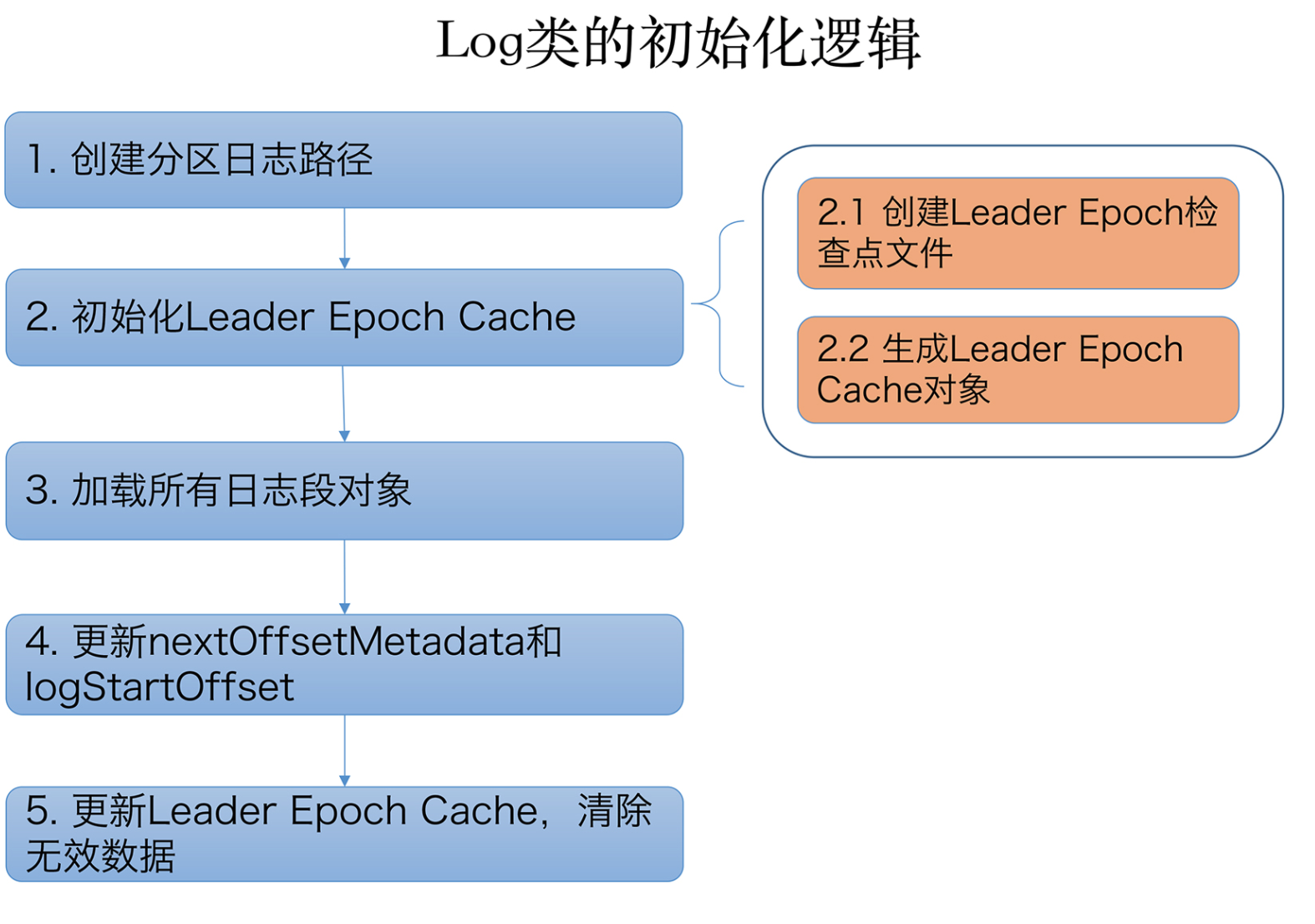
Leader Epoch暂且不表,我们看看loadSegments是如何加载日志段的。
loadSegments
private def loadSegments(): Long = {
// first do a pass through the files in the log directory and remove any temporary files
// and find any interrupted swap operations
//移除上次 Failure 遗留下来的各种临时文件(包括.cleaned、.swap、.deleted 文件等)
val swapFiles = removeTempFilesAndCollectSwapFiles()
// Now do a second pass and load all the log and index files.
// We might encounter legacy log segments with offset overflow (KAFKA-6264). We need to split such segments. When
// this happens, restart loading segment files from scratch.
//清空所有日志段对象,并且再次遍历分区路径,重建日志段 segments Map 并删除无对应日志段文件的孤立索引文件。
retryOnOffsetOverflow {
// In case we encounter a segment with offset overflow, the retry logic will split it after which we need to retry
// loading of segments. In that case, we also need to close all segments that could have been left open in previous
// call to loadSegmentFiles().
//先清空日志段信息
logSegments.foreach(_.close())
segments.clear()
//从文件中装载日志段
loadSegmentFiles()
}
// Finally, complete any interrupted swap operations. To be crash-safe,
// log files that are replaced by the swap segment should be renamed to .deleted
// before the swap file is restored as the new segment file.
//完成未完成的 swap 操作
completeSwapOperations(swapFiles)
if (!dir.getAbsolutePath.endsWith(Log.DeleteDirSuffix)) {
val nextOffset = retryOnOffsetOverflow {
recoverLog()
}
// reset the index size of the currently active log segment to allow more entries
activeSegment.resizeIndexes(config.maxIndexSize)
nextOffset
} else {
if (logSegments.isEmpty) {
addSegment(LogSegment.open(dir = dir,
baseOffset = 0,
config,
time = time,
fileAlreadyExists = false,
initFileSize = this.initFileSize,
preallocate = false))
}
0
}
}
这个方法首先会调用removeTempFilesAndCollectSwapFiles方法移除上次 Failure 遗留下来的各种临时文件(包括.cleaned、.swap、.deleted 文件等)。
然后它会清空所有日志段对象,并且再次遍历分区路径,重建日志段 segments Map 并删除无对应日志段文件的孤立索引文件。
待执行完这两次遍历之后,它会完成未完成的 swap 操作,即调用 completeSwapOperations 方法。等这些都做完之后,再调用 recoverLog 方法恢复日志段对象,然后返回恢复之后的分区日志 LEO 值。
removeTempFilesAndCollectSwapFiles
private def removeTempFilesAndCollectSwapFiles(): Set[File] = {
// 在方法内部定义一个名为deleteIndicesIfExist的方法,用于删除日志文件对应的索引文件
def deleteIndicesIfExist(baseFile: File, suffix: String = ""): Unit = {
info(s"Deleting index files with suffix $suffix for baseFile $baseFile")
val offset = offsetFromFile(baseFile)
Files.deleteIfExists(Log.offsetIndexFile(dir, offset, suffix).toPath)
Files.deleteIfExists(Log.timeIndexFile(dir, offset, suffix).toPath)
Files.deleteIfExists(Log.transactionIndexFile(dir, offset, suffix).toPath)
}
var swapFiles = Set[File]()
var cleanFiles = Set[File]()
var minCleanedFileOffset = Long.MaxValue
for (file <- dir.listFiles if file.isFile) {
if (!file.canRead)
throw new IOException(s"Could not read file $file")
val filename = file.getName
//如果是以.deleted结尾的文件
if (filename.endsWith(DeletedFileSuffix)) {
debug(s"Deleting stray temporary file ${file.getAbsolutePath}")
// 说明是上次Failure遗留下来的文件,直接删除
Files.deleteIfExists(file.toPath)
// 如果是以.cleaned结尾的文件
} else if (filename.endsWith(CleanedFileSuffix)) {
minCleanedFileOffset = Math.min(offsetFromFileName(filename), minCleanedFileOffset)
cleanFiles += file
// .swap结尾的文件
} else if (filename.endsWith(SwapFileSuffix)) {
// we crashed in the middle of a swap operation, to recover:
// if a log, delete the index files, complete the swap operation later
// if an index just delete the index files, they will be rebuilt
//更改文件名
val baseFile = new File(CoreUtils.replaceSuffix(file.getPath, SwapFileSuffix, ""))
info(s"Found file ${file.getAbsolutePath} from interrupted swap operation.")
//如果该.swap文件原来是索引文件
if (isIndexFile(baseFile)) {
// 删除原来的索引文件
deleteIndicesIfExist(baseFile)
// 如果该.swap文件原来是日志文件
} else if (isLogFile(baseFile)) {
// 删除掉原来的索引文件
deleteIndicesIfExist(baseFile)
// 加入待恢复的.swap文件集合中
swapFiles += file
}
}
}
// KAFKA-6264: Delete all .swap files whose base offset is greater than the minimum .cleaned segment offset. Such .swap
// files could be part of an incomplete split operation that could not complete. See Log#splitOverflowedSegment
// for more details about the split operation.
// 从待恢复swap集合中找出那些起始位移值大于minCleanedFileOffset值的文件,直接删掉这些无效的.swap文件
val (invalidSwapFiles, validSwapFiles) = swapFiles.partition(file => offsetFromFile(file) >= minCleanedFileOffset)
invalidSwapFiles.foreach { file =>
debug(s"Deleting invalid swap file ${file.getAbsoluteFile} minCleanedFileOffset: $minCleanedFileOffset")
val baseFile = new File(CoreUtils.replaceSuffix(file.getPath, SwapFileSuffix, ""))
deleteIndicesIfExist(baseFile, SwapFileSuffix)
Files.deleteIfExists(file.toPath)
}
// Now that we have deleted all .swap files that constitute an incomplete split operation, let‘s delete all .clean files
// 清除所有待删除文件集合中的文件
cleanFiles.foreach { file =>
debug(s"Deleting stray .clean file ${file.getAbsolutePath}")
Files.deleteIfExists(file.toPath)
}
// 最后返回当前有效的.swap文件集合
validSwapFiles
}
处理完了removeTempFilesAndCollectSwapFiles方法,然后进入到loadSegmentFiles方法中。
loadSegmentFiles
private def loadSegmentFiles(): Unit = {
// load segments in ascending order because transactional data from one segment may depend on the
// segments that come before it
for (file <- dir.listFiles.sortBy(_.getName) if file.isFile) {
//如果不是以.log结尾的文件,如.index、.timeindex、.txnindex
if (isIndexFile(file)) {
// if it is an index file, make sure it has a corresponding .log file
val offset = offsetFromFile(file)
val logFile = Log.logFile(dir, offset)
// 确保存在对应的日志文件,否则记录一个警告,并删除该索引文件
if (!logFile.exists) {
warn(s"Found an orphaned index file ${file.getAbsolutePath}, with no corresponding log file.")
Files.deleteIfExists(file.toPath)
}
// 如果是以.log结尾的文件
} else if (isLogFile(file)) {
// if it‘s a log file, load the corresponding log segment
val baseOffset = offsetFromFile(file)
val timeIndexFileNewlyCreated = !Log.timeIndexFile(dir, baseOffset).exists()
// 创建对应的LogSegment对象实例,并加入segments中
val segment = LogSegment.open(dir = dir,
baseOffset = baseOffset,
config,
time = time,
fileAlreadyExists = true)
try segment.sanityCheck(timeIndexFileNewlyCreated)
catch {
case _: NoSuchFileException =>
error(s"Could not find offset index file corresponding to log file ${segment.log.file.getAbsolutePath}, " +
"recovering segment and rebuilding index files...")
recoverSegment(segment)
case e: CorruptIndexException =>
warn(s"Found a corrupted index file corresponding to log file ${segment.log.file.getAbsolutePath} due " +
s"to ${e.getMessage}}, recovering segment and rebuilding index files...")
recoverSegment(segment)
}
addSegment(segment)
}
}
}
接下来调用completeSwapOperations方法处理有效.swap 文件集合。
completeSwapOperations
private def completeSwapOperations(swapFiles: Set[File]): Unit = {
// 遍历所有有效.swap文件
for (swapFile <- swapFiles) {
val logFile = new File(CoreUtils.replaceSuffix(swapFile.getPath, SwapFileSuffix, ""))
val baseOffset = offsetFromFile(logFile)// 拿到日志文件的起始位移值
// 创建对应的LogSegment实例
val swapSegment = LogSegment.open(swapFile.getParentFile,
baseOffset = baseOffset,
config,
time = time,
fileSuffix = SwapFileSuffix)
info(s"Found log file ${swapFile.getPath} from interrupted swap operation, repairing.")
// 执行日志段恢复操作
recoverSegment(swapSegment)
// We create swap files for two cases:
// (1) Log cleaning where multiple segments are merged into one, and
// (2) Log splitting where one segment is split into multiple.
//
// Both of these mean that the resultant swap segments be composed of the original set, i.e. the swap segment
// must fall within the range of existing segment(s). If we cannot find such a segment, it means the deletion
// of that segment was successful. In such an event, we should simply rename the .swap to .log without having to
// do a replace with an existing segment.
// 确认之前删除日志段是否成功,是否还存在老的日志段文件
val oldSegments = logSegments(swapSegment.baseOffset, swapSegment.readNextOffset).filter { segment =>
segment.readNextOffset > swapSegment.baseOffset
}
// 如果存在,直接把.swap文件重命名成.log
replaceSegments(Seq(swapSegment), oldSegments.toSeq, isRecoveredSwapFile = true)
}
}
最后是执行recoverLog部分代码。
recoverLog
private def recoverLog(): Long = {
// if we have the clean shutdown marker, skip recovery
// 如果不存在以.kafka_cleanshutdown结尾的文件。通常都不存在
if (!hasCleanShutdownFile) {
// okay we need to actually recover this log
// 获取到上次恢复点以外的所有unflushed日志段对象
val unflushed = logSegments(this.recoveryPoint, Long.MaxValue).toIterator
var truncated = false
// 遍历这些unflushed日志段
while (unflushed.hasNext && !truncated) {
val segment = unflushed.next
info(s"Recovering unflushed segment ${segment.baseOffset}")
val truncatedBytes =
try {
// 执行恢复日志段操作
recoverSegment(segment, leaderEpochCache)
} catch {
case _: InvalidOffsetException =>
val startOffset = segment.baseOffset
warn("Found invalid offset during recovery. Deleting the corrupt segment and " +
s"creating an empty one with starting offset $startOffset")
segment.truncateTo(startOffset)
}
if (truncatedBytes > 0) {// 如果有无效的消息导致被截断的字节数不为0,直接删除剩余的日志段对象
// we had an invalid message, delete all remaining log
warn(s"Corruption found in segment ${segment.baseOffset}, truncating to offset ${segment.readNextOffset}")
removeAndDeleteSegments(unflushed.toList, asyncDelete = true)
truncated = true
}
}
}
// 这些都做完之后,如果日志段集合不为空
if (logSegments.nonEmpty) {
val logEndOffset = activeSegment.readNextOffset
if (logEndOffset < logStartOffset) {
warn(s"Deleting all segments because logEndOffset ($logEndOffset) is smaller than logStartOffset ($logStartOffset). " +
"This could happen if segment files were deleted from the file system.")
removeAndDeleteSegments(logSegments, asyncDelete = true)
}
}
// 这些都做完之后,如果日志段集合为空了
if (logSegments.isEmpty) {
// no existing segments, create a new mutable segment beginning at logStartOffset
// 至少创建一个新的日志段,以logStartOffset为日志段的起始位移,并加入日志段集合中
addSegment(LogSegment.open(dir = dir,
baseOffset = logStartOffset,
config,
time = time,
fileAlreadyExists = false,
initFileSize = this.initFileSize,
preallocate = config.preallocate))
}
// 更新上次恢复点属性,并返回
recoveryPoint = activeSegment.readNextOffset
recoveryPoint
}
Kafka源码解析(一)---LogSegment以及Log初始化
原文:https://www.cnblogs.com/luozhiyun/p/13062835.html